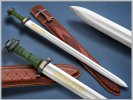- Joined
- Feb 3, 2020
- Messages
- 107
I'm currently working on my first European sword, a Viking era blade. I'm in the process of grinding in the distal taper and have a few references out there, two decent ones based on historic swords. One calls for a 5mm thickness near the hilt to 2.5mm nearing the tip. I'm more or less following this idea on my stock removal, .2575" 80CRV2 blank. I'd like to see what others think on distal for a European sword while I'm grinding away, which seems to take quite a long time at 36 Grit belts.





